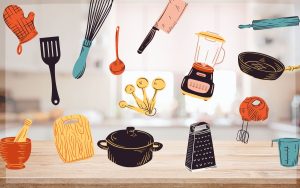A well-prepped and organized kitchen is the heart of a functional and stress-free cooking experience. Whether you’re a seasoned home chef or just starting your culinary journey, having an organized kitchen can save you time, reduce clutter, and enhance your overall cooking experience. In this post, we’ll provide you with valuable tips and insights to help you transform your kitchen into an efficient and harmonious space. So let’s dive in and discover the secrets to a beautifully prepped and organized kitchen!

Assessing Your Kitchen Space
When it comes to prepping and organizing your kitchen, the first step is to assess your kitchen space thoroughly. Take a close look at your kitchen layout and available storage options to get a clear understanding of the space you have to work with. This assessment will help you identify any problem areas and determine the best solutions to optimize your kitchen’s functionality and organization.
Evaluating Your Kitchen Layout and Flow
Begin by examining the layout of your kitchen. Consider the placement of key elements like the sink, stove, refrigerator, and countertops. Assess how they relate to each other and the overall flow of your kitchen. Are there any bottlenecks or areas where movement feels restricted? This evaluation will help you determine if there are any layout changes or adjustments needed to create a more efficient workspace.
Identifying Problem Areas
Next, identify any problem areas in your kitchen. Are there specific spots that always seem cluttered or disorganized? Perhaps you struggle with limited cabinet or countertop space. Take note of these challenges as they will guide you in finding appropriate solutions. Common problem areas include overcrowded pantries, messy spice racks, and cluttered countertops.
Determining Storage Needs
Assess the available storage options in your kitchen. Take stock of your cabinets, drawers, pantry, and even wall space that can be utilized for storage purposes. Evaluate whether your current storage solutions are adequate or if you need to incorporate additional storage solutions. This step will help you plan for the types of organizers, shelves, or racks you may need to maximize your storage potential.
By thoroughly assessing your kitchen space, evaluating the layout, identifying problem areas, and determining your storage needs, you’ll be equipped with valuable insights to tackle the organization process effectively. Understanding your kitchen’s strengths and weaknesses will allow you to develop tailored solutions that fit your specific needs, setting the stage for a beautifully prepped and organized kitchen.
Decluttering and Streamlining
Decluttering and streamlining your kitchen is a crucial step in creating a well-prepped and organized space. By removing unnecessary items and streamlining your kitchen tools and equipment, you’ll not only free up valuable space but also make it easier to find and access what you need when preparing meals. Let’s explore some strategies and subheadings to guide you through this process.
Getting Rid of Unnecessary Items
Begin by thoroughly decluttering your kitchen. Start with your cabinets, pantry, and countertops. Assess each item and ask yourself if it’s truly necessary or if it’s taking up valuable space without serving a purpose. Donate or discard items that are broken, unused, or no longer needed. Be ruthless in your decluttering process to create a clean and clutter-free environment.
Streamlining Kitchen Tools and Equipment
Kitchen tools and equipment can quickly accumulate and take up precious space. Streamline your collection by keeping only the items you use regularly or those that serve multiple purposes. Consider donating or selling duplicate items or ones you rarely use. This will not only declutter your kitchen but also make it easier to find and access the tools you need, saving you time and reducing frustration.
Organizing Small Appliances
Small appliances, such as blenders, toasters, and mixers, can clutter your countertops and cabinets. Assess which appliances you use frequently and consider keeping them easily accessible on the countertop. For the appliances you use less often, find designated storage spaces in your cabinets or pantry. Keep cords neatly wrapped and labeled to avoid tangled messes.
Sorting Through Cookware and Bakeware
Cookware and bakeware often take up a significant amount of space in your kitchen. Assess each piece and consider its condition and functionality. Discard or donate any damaged or seldom-used items. Invest in stackable or nesting cookware to maximize cabinet space. Utilize drawer dividers or racks to keep lids and pans organized and easily accessible.
Categorizing and Grouping
Categorizing and grouping items in your kitchen is a fundamental step towards achieving a well-organized and efficient space. By creating functional zones and organizing items based on their use and frequency, you’ll be able to streamline your cooking process and easily locate what you need. Let’s delve into some strategies and subheadings to help you categorize and group effectively.
Creating Functional Zones
Designate specific areas in your kitchen for different purposes or activities. For example, create a baking zone where you store baking ingredients, tools, and pans together. Establish a cooking zone near the stove where you keep pots, pans, and cooking utensils. Having these functional zones will help you streamline your workflow and minimize time spent searching for items in different areas of the kitchen.
Categorizing Items Based on Use
Sort and categorize your kitchen items based on their use and frequency. Group similar items together, such as grouping all baking supplies, spices, or canned goods in separate sections. This approach allows you to quickly locate and access what you need for specific cooking tasks without rummaging through multiple areas. Consider using clear containers or bins to further organize and visually separate different categories.
Organizing by Frequency of Use
Arrange your kitchen items based on how frequently you use them. Keep everyday essentials, like plates, glasses, and utensils, in easily accessible areas such as upper cabinets or drawers. Store less frequently used items, such as special occasion serving wares or seasonal items, in higher or lower shelves or in the back of cabinets. This way, you can optimize the space and ensure that items you use most often are within reach.
Implementing Labeling Systems
Labels can be incredibly helpful in maintaining an organized kitchen. Use labels on shelves, containers, and drawers to indicate the contents and help everyone in the household know where items belong. Labeling also aids in maintaining consistency and prevents items from being misplaced or forgotten. Consider using chalkboard labels or adhesive labels that can be easily removed or changed as needed.
Maximizing Storage
Maximizing storage is a key aspect of prepping and organizing your kitchen. Efficiently utilizing your cabinet and pantry space, as well as considering additional storage solutions, will help you make the most of your kitchen’s storage potential. Let’s explore some strategies and subheadings to guide you in maximizing your kitchen storage.
Utilizing Cabinet and Pantry Space Effectively
Evaluate your cabinet and pantry space to make the most of the available area. Start by decluttering and removing items that are no longer needed or expired. Use stackable shelves or risers to maximize vertical space in your cabinets. Install hooks on the inside of cabinet doors to hang measuring cups, oven mitts, or small utensils. Consider utilizing clear bins or organizers to group and contain items, making them easier to find and access.
Installing Additional Storage Solutions
If your kitchen has limited storage options, consider installing additional storage solutions to maximize the space. Wall-mounted racks or pegboards can be used to hang pots, pans, and cooking utensils, freeing up cabinet space. Magnetic strips can be mounted on walls or inside cabinet doors to hold metal tools and knives. Utilize the space above your cabinets by placing decorative baskets or bins to store items that are used less frequently.
Incorporating Shelves and Racks
Make use of unused wall space or corners by installing shelves and racks. Floating shelves can be mounted on walls to display and store cookbooks, spices, or decorative items. Corner shelves can be used to optimize corner spaces and provide additional storage for items such as small appliances or serving wares. Consider adjustable wire racks for inside cabinets to create additional levels and compartments for stacking plates, bowls, or cups.
Utilizing Vertical Space
Don’t forget to utilize the vertical space in your kitchen. Install hooks or racks on walls or the sides of cabinets to hang mugs, utensils, or towels. Install a pot rack above your kitchen island or stove to free up cabinet space and create a visually appealing display. Hang a spice rack on the inside of a cabinet door or use a magnetic spice rack on the refrigerator to keep spices organized and within reach.
Organizing Your Kitchen Tools and Utensils
Organizing your kitchen tools and utensils is essential for a well-prepped and efficient cooking experience. By sorting, arranging, and using appropriate organizers, you can easily access the tools you need and maintain a tidy kitchen workspace. Let’s explore some strategies and subheadings to help you organize your kitchen tools and utensils effectively.
Sorting and Arranging Cooking Utensils
Start by sorting through your collection of cooking utensils. Remove any items that are damaged, worn out, or rarely used. Group similar utensils together, such as spatulas, ladles, and tongs. Consider arranging them in a dedicated utensil holder or crock on the countertop for easy access. Alternatively, use drawer dividers to neatly separate utensils in a drawer, ensuring they are organized and readily available.
Using Drawer Dividers and Organizers
Utilize drawer dividers and organizers to keep your kitchen tools in order. Dividers will help separate different utensils and prevent them from becoming a jumbled mess. Consider using adjustable dividers to accommodate utensils of various sizes. You can also use utensil trays or organizers specifically designed to hold and separate different types of tools, such as knives or measuring spoons.
Hanging Utensils for Accessibility
Hanging utensils can be a space-saving and visually appealing solution. Install hooks or a hanging rail on the wall or backsplash near your cooking area. Hang frequently used utensils, such as spatulas, whisks, and slotted spoons, for quick and convenient access. This not only frees up drawer space but also adds a decorative touch to your kitchen.
Organizing Specialty Tools
Specialty tools, such as graters, zesters, and can openers, often have irregular shapes that can be challenging to store. Consider using a designated container or drawer with dividers to keep these tools organized and prevent them from getting tangled or damaged. Utilize magnetic strips or hooks to store metal tools, like measuring spoons or ladles, on the side of your refrigerator or the inside of a cabinet door.
Creating a System for Food Storage
Creating a well-organized system for food storage is crucial for maintaining freshness, preventing waste, and maximizing your kitchen’s efficiency. By implementing proper storage techniques and utilizing suitable containers, you can ensure that your food stays fresh, easily accessible, and properly organized. Let’s explore some strategies and subheadings to help you create an effective system for food storage.
Categorizing and Labeling
Start by categorizing your food items to facilitate organization. Group similar items together, such as grains, canned goods, snacks, or baking ingredients. Store them in separate sections of your pantry or designated cabinets. Use clear containers or bins to keep items visible and easily identifiable. Label each container or shelf to indicate the contents, expiry dates, or cooking instructions. This will help you quickly locate specific items and maintain an organized pantry.
Optimal Use of Pantry Space
Make the most of your pantry space by utilizing shelves, racks, and organizers. Install adjustable shelving to accommodate different-sized items and maximize vertical space. Use tiered organizers to create additional levels for canned goods or spices. Consider installing door-mounted racks or organizers to store smaller items like spice jars or condiments. Maximize deep shelves by using stackable storage containers or turntables to access items at the back easily.
Utilizing Airtight Containers
Invest in airtight containers to store dry goods like cereals, grains, and baking ingredients. Airtight containers not only help keep your food fresh but also prevent pantry pests from infesting your supplies. Transfer items from their original packaging into these containers, ensuring you label each one. Clear containers allow you to see the contents at a glance, making it easier to identify what you need and when to restock.
Properly Storing Perishables
For perishable items like fruits, vegetables, and leftovers, proper storage is crucial. Use clear, stackable containers or storage bags to store chopped fruits and vegetables in the refrigerator, ensuring they are properly sealed to maintain freshness. Keep similar items together in designated refrigerator drawers or sections. Label and date leftovers to ensure they are consumed before they spoil. Consider using transparent bins or trays to keep your refrigerator organized and prevent items from getting lost or buried.
Setting Up a Functional Fridge and Freezer
Setting up a functional fridge and freezer is essential for keeping your perishable items fresh, organizing your groceries, and optimizing storage space. By strategically arranging items, maintaining proper temperature settings, and utilizing storage solutions, you can create an efficient and well-organized refrigeration system. Let’s explore some strategies and subheadings to help you set up a functional fridge and freezer.
Temperature and Organization
Ensure that your fridge and freezer are set to the appropriate temperatures to maintain food safety and freshness. The fridge should be kept between 35°F (1.6°C) and 38°F (3.3°C), while the freezer should be set at 0°F (-17.8°C) or below. This helps prevent bacterial growth and keeps your food at optimal freshness.
Fridge Organization
Start by decluttering your fridge and removing any expired or spoiled items. Categorize your items to make them easier to locate. Designate specific areas for different types of food, such as fruits and vegetables, dairy products, beverages, and condiments. Keep frequently used items within easy reach, while placing less frequently used items towards the back. Use clear bins or organizers to group similar items together and maintain an organized fridge.
Proper Storage Techniques
Maximize your fridge’s storage potential by utilizing proper storage techniques. Keep raw meats and fish on the lower shelves or in sealed containers to prevent cross-contamination. Place delicate produce in the crisper drawer to maintain their freshness. Use clear, airtight containers or storage bags to store leftovers or partially opened packages. This helps keep the food fresh and prevents odors from spreading.
Freezer Organization
Organize your freezer to make it easy to find and access items. Group similar items together, such as meats, frozen vegetables, or prepared meals. Consider using freezer-safe storage containers or bags to keep items properly sealed and prevent freezer burn. Label each container with the contents and date to ensure you rotate items and use them before they expire. Utilize freezer shelves, baskets, or organizers to separate and categorize different types of frozen foods.
Maximizing Freezer Space
To maximize freezer space, use vertical storage solutions. Invest in stackable storage bins or wire baskets to create layers and separate different items. Consider using vacuum-sealed bags to compress and save space for bulkier items. Use freezer-safe bags or containers to store smaller items like berries or herbs. Keeping an inventory list on the freezer door can help you keep track of what you have on hand and avoid overstocking.
Conclusion
Congratulations on taking the first steps towards creating a prepped and organized kitchen! By implementing the tips and strategies shared in this blog post, you’re well on your way to enjoying a more efficient, enjoyable, and stress-free cooking experience. Remember, organizing your kitchen is not a one-time task, but an ongoing process that requires consistent effort and maintenance. Regularly declutter, clean, and optimize your kitchen space to ensure it remains functional and organized. With a well-prepped and organized kitchen, you’ll be able to unleash your culinary creativity, save time, and create delicious meals with ease.









